ULI’s ‘Bold Idea’ At The Grand MetroLink Station
A week ago today the Urban Land Institute (ULI) presentation by their Technical Assistance Panel (TAP) regarding transit-oriented development (TOD) at the Grand MetroLink light rail station. The real estate experts from the ULI were asked by Citizens for Modern Transit (CMT) to consider short and long-term solutions.
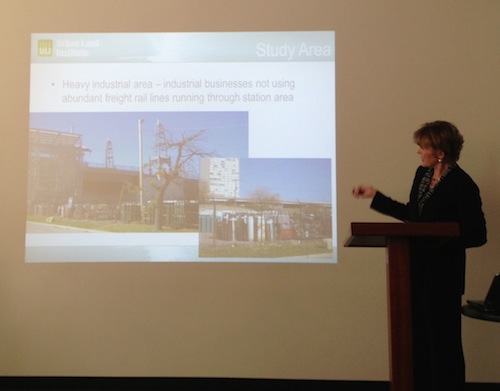
The long-term section included three bold ideas that would evoke an “audible gasp”. First, look again at the Chouteau Greenway concept linking downtown to Forest Park. Second was a high speed rail station at Grand since plenty of room exists.
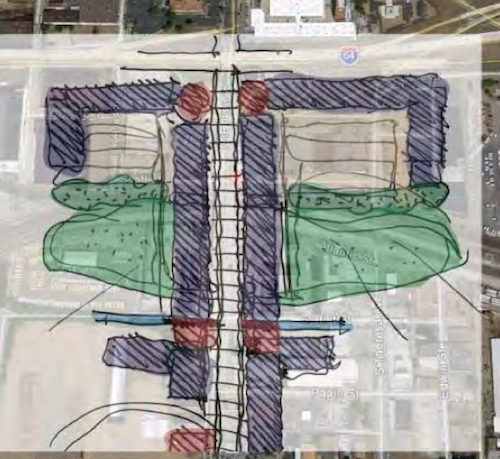
The final bold idea generated was to move from focusing on the station which sits below grade to building above the station – a platform development at street level. Some of the merits of this type of develoopment included:
- Place parking on first 2-3 stories, easily fitting below bridge
- Place commercial, retail and/or residential on top of parking, level with the bridge platform
- Embraces light rail and bus connectivity
- Builds connection between SLU campuses
- Enhances travel along Grand and encourages pedestrian use
Sounds familiar, oh yeah I proposed this in January 2006 when it was announced the old viaduct would be replaced: Grand Bridge Should Follow Columbus Ohio Example.
Here are a few points from nearly 7 years ago:
- In addition to building structured parking the area could have office and condo uses to compliment the street-level retail. The office space could include high-tech bio-med facilities as part of the CORTEX plan.
- This bridge turned retail street could serve as a needed campus hangout area for both SLU campuses. It could include a coffee house (or two) as well as a copy center like a Kinko’s.
- With plenty of structured parking, on-street parking, bus routes and MetroLink this could be a happening spot! With land on each side of the tracks and highway we’d be building not bridges but buildings that happen to have a floor that aligns with the bridge sidewalks.
- Before all the naysayers try to explain why we cannot be urban let me try to address a few points. The area has already been blighted and is going to be redeveloped. Building new buildings up to the existing bridge is feasible, perhaps more so than the plan to add width and medians to the current structure. Also, we can be urban and what better place to create an urban street than at a location with a MetroLink light rail stop and between two major university campuses.

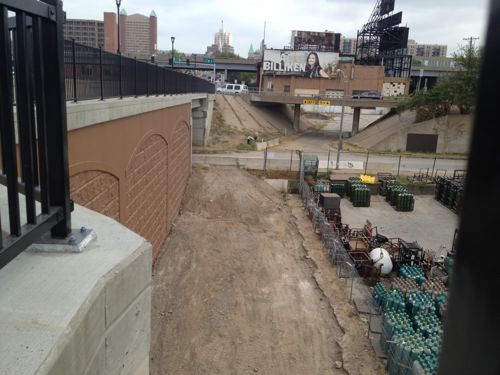
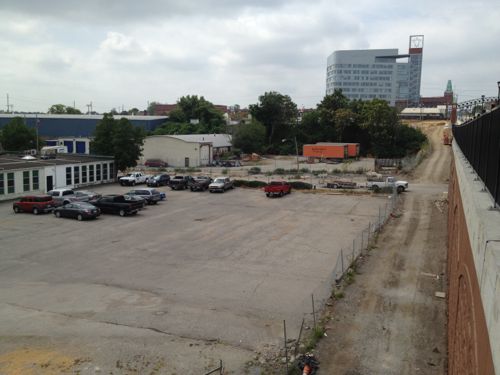
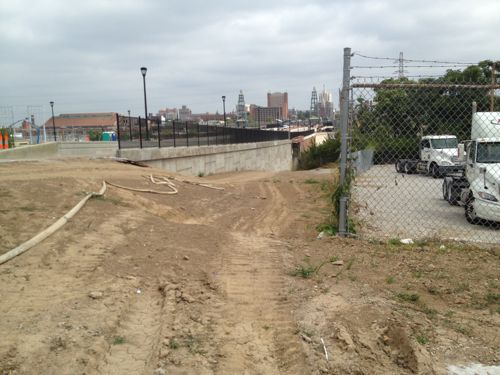
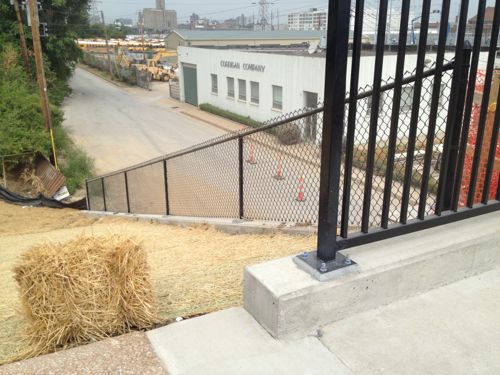
If only the viaduct/bridge had been designed to facilitate development at the edges, simply by removing sections of railing. Still, as ULI’s experts how shown, it is still a viable bold idea worth considering.
— Steve Patterson
I’ve said it before, I’ll say it again – these are all great ideas. They’ve also been created in an intellectual vacuum, one that ignores the realities of financing and demand by the market. Who’s gonna pay for this? Why should they pay for it? “Because they should” ain’t good enough. “It’s critical to the urban fabric” or “It builds on our existing transit investments” are worthy public-sector arguments, but carry little weight in the private sector. Should we create an urban renewal agency to build the below-Grand parking? Can they define a viable funding mechanism? TIF? CID? Bonds? The real challenge is that any private developer can go a mile in any direction and find plenty of land that would not require structured parking or building on stilts, unlike here . . . .
fewer and fewer people come into St. louis or to St. louis. This is so ‘not needed’.
The ULI team represent fields that look at financing, land acquisition, etc. They know, as do I, that demand isn’t always readily apparent but it can be brought out of the woodwork. People said there was no demand for downtown lofts until it was done and then people suddenly realized there was demand after all. If they listened to you, we’d still have lots of vacant warehouses.
Agree – that’s what I said – “these are all great ideas”. My point is that it takes more than just a “great idea”, it takes financial resources and it takes leadership, much like Joe Edwards’ lead on historic tax credits that made lofts financially viable. And for that to happen here, there needs to be some valid economic arguments, not just vaguely-defined blocking studies and free-hand sketches. Removing the railing is the least of the challenges, finding the right (any?) tenants IS! Possible ones include Walgreens or CVS, Whole Foods or Trader Joe’s, Target or Walmart, Dollar Tree or Dollar General, or (most likely) SLU, it’s subsidiaries and related enterprises and/or businesses serving SLU students. Until you know the type of tenant(s), you can’t move beyond conceptual sketches and you can’t go to a bank for financing.
is this the urban land institute that sent 8 knuckle-heads here in August of 1998 to tell us St. louis was a ‘small town and could not support kiel opera house and the Fox’? That the opera house should be gutted for re-use? is this the same group? is this the group that supported and marketed the ballpark-ballpark village deal a decade-long fraud? Do these folks not see how St. louis was passed up by another dozen or so cities, each of the last 2 decades? This is another diversion away from actually bringing back Downtown, which midtown will never allow, ever.
It does seem to address the most common issue for dense environments which is parking. It is a great location that could be used by Cards/Blues fans as a parking spot and then a quick metro ride to either venue with entertainment/shopping before and after. There are enough college kids traversing the area between the campus areas that it might work. Interesting idea.
How many times are you going to trot this ill-conceived Idea out there? There are too many other parcels of property available that don’t require the special considerations you and this development organization cavalierly throw out there while assuming an infinite pot of money is available.
This has not been one of your better weeks.
Only one spot on the busiest bus line connecting with light rail.
Most transit riders, especially daily commuters, have absolutely no interest in lingering or shopping when they make connections. They want a quick, convenient, safe, short, seamless transfer between one route and another; they’ll do the bulk of their shopping either at their origin or their destination, or both, not somewhere in the middle!
Yes, bringing in high-speed rail would add another dimension, but that assumes that the current, new, multi-modal facility will be going away. If not, you’ve defeated the whole argument for, and concept of, “high speed”! (And if you want to do a successful TOD project, the Civic Center Station would be a much better candidate than the Grand Station, for multiple reasons.)
Regarding ULI’s fourth point: “Builds connection between SLU campuses.”
There is nothing shown in the actions (or inactions) of SLU leadership over the past twenty years that makes me believe they are interested in any connections other than those they themselves may make. Their approach has been one of systematic demolition of this stretch and aggressive (with a capital ‘A’) expansion to the south.
If this plan were to happen, it would have to be done by SLU. And developmentally, I don’t believe SLU is interested in anything else right now than expanding its reach, destroying what currently exists and maybe — maybe — doing some quality infill 20 years down the road when it effectively owns the entire Grand stretch south to Compton Hill.
I don’t see what would be wrong with continue to encourage commercial and light industrial use as it is now. Why not move or shuffle some current commercial users to create larger plots for light industrial/commercial development or create smaller commerical work space (not talking about artist lofts). As noted, the area has great transit access, central located to the region as well as I-64/Hwy. Why doesn’t the promote light industrial jobs here on its location and strengths instead of the idea that you always need to come up a residential/retail answer around every transit. stop
A block away from Grand is never going to be retail, but why must industrial need to but up next to Grand? It doesn’t.
So you put retail here instead of SLU medical campus? assuming SLU would replace what they have demolished. or put retail here instead of expanding retail on north side where the saucer is at? or put more retail with more infill in Grand Center, specifically corner of Grand and Lindell? My point, their isn’t enough density, demographics by a long shot that every corridor on every major street can support what you are talking about, let alone the idea you spend the capital to build the infrastructure to support the platform/garages for retail at viaduct level when their is plenty of infill needed on Grand as it is. So why not support a why to expand something and therefore jobs of something that already exists. Instead, I would invest that capital in a grade level intersection of Grand & Forest Parkway or Grand BRT/Streetcar or even improve the pedestarian access immediately around the current station as you suggested in an earlier post. Another way to put it, their is a lot more work to do up and down Grand before a bold vision is needed here.
The retail would be a small percentage of the new buildings, just at the sidewalk level. Not an either/or situation. Retail with other uses on upper floors.
Another thought. CMT, Metrolink, the cities leadership and others need to continue to push for a bold TOD vision of Forest Park Station and Delmar Station and even Cortex proposed Boyle Ave station. You can build the mixed use residential/office/retail without a large infrastructure investment to literally support it.
Why was/is industrial “up next to Grand”? Because the rail lines are there to get raw materials in and finished products out, and the Grand streetcar / bus line was/is a great way for their employees to get to work. Not every corridor is going to see (or need) wall-to-wall retail!
Yes, that worked great in the 19th and early 20th centuries, but this is the 21st century. We need to make the environment more conducive to walking to make our investment in transit infrastructure payoff.
And the way you do that is promote putting decent jobs back next to the infrastrucre that is there and built. Part time retails jobs are not going to cut it and building structures in order to build housing stock on top for viaduct level in a city full of underutilized structures and empty space makes absolutely no economic sense. What the city needs to do is get back to promoting strengths on why you might want to relocate your business, commercial, light industrial back into the areas where they once thrived as JZ noted. Its not a 19th, 20th or 21st century mentality. Its a mentality that cities work and thrive when their jobs to be had.
The jobs will be in the new research buildings that’ll be built. The retail is simply to make the walk from transit to the jobs more pleasant.
It is a great idea, one among many, including Steve’s post comparing the Grand Bridge to Columbus Ohio (has it really been 7 years?)
Broad plans are good in that they can generate developer interest. The problem is they have to come from the city government, not ULI. The blog Preservation Office recently indicated that current urban planning is still based on the 1948 comprehensive plan. How crazy is that?
The truth is the lack of money isn’t the problem.
A broader understanding of how this light rail, bus station should fit into the rest of the city development is central to generating the funds and the money that is claimed to be lacking.
Capitalists today tend to only bet on sure things, especially looking for government money to insure their profitability. Forget risk taking.
The site around the main train station on Grand is begging for student and worker apartments, condos, penthouses, density, walking retail. What do the capitalists want an invitation, guaranteed money, what? The site would fill up rapidly, yet no development.
If connected to a larger, recognizable transit system, it will support further development elsewhere reinforcing itself.
The capitalists are failures at this site. A huge public investment in light rail, buses and a new bridge and the capitalists can’t figure out how to make money where people gather? That is amazing to consider.
At a minimum the Board of Alderman should pass an ordinance creating zoning districts around the Grand Ave and other stations that will protect and support the considerable public investment in transit.
I’ll repeat, constructing stuff takes money. If the private sector capitalists don’t want to spend it here, and the public sector either doesn’t have the money to spend or a good reason to spend it here, please explain how “creating zoning districts” or creating “broad plans” will change what’s happening now / move things off dead center. If it’s true, that “the site around the main train station on Grand is begging for student and worker apartments, condos, penthouses, density, walking retail”, why are there no plans in place, no proposed projects, from SLU, from Harris-Stowe, from BNSF, from the private sector or from the city? If you, Steve and the ULI all think that this is the greatest idea since sliced bread, tell us how to finance it, to actually implement this wonderful concept.
Ignoring financial reality, I can come up with many, many “great ideas”, for here or on pretty much any other site – how about a performing arts complex, with a new concert hall and several theaters of various sizes and formats? How about an IKEA, conveniently located on transit and between two freeways? How about an aquarium? A convention center? Heck, why not build the Rams a new stadium here? Or, build Larry Rice a new home, where he wouldn’t be bothering anybody (and his clients would have great transit access, to jobs and other services)? How about a great urban recreation complex, jointly financed by SLU, the city and the YMCA? How about a new jail, to replace the old facilities on Hall Street? Any of these ideas “could” work here; the real question is should any of them be sited here? For financial reasons? For political reasons? For urban design reasons?
The fundamental problem here was the decision to replace the old viaduct with a new one. Viaducts are usually meant to move traffic over flood plains, rail yards and industrial areas, not to provide easy connections to them: http://en.wikipedia.org/wiki/Viaduct . When Denver had to replace several viaducts (similar to the Grand viaduct) at the end of the last century, one was converted to an on-grade street (15th Street), one was made significantly shorter (20th Street) and one was converted from an overpass to an underpass (Broadway). All three choices created more at-grade opportunities and all three have seen significant new developments. Here, we have maintained a truly sucky pedestrian experience, a half mile hike, with bridges and ramps for both Forest Park Parkway and I-64 in addition to the “new, improved” viaduct. Putting a major transit connection in the middle doesn’t make it better, it just makes for a sucky connection point!
I’ll repeat, it isn’t the money. It is haphazard approaches to city planning that discourage development. Who would want to invest money in a transit orientated project when the city can allow a huge parking lot that serves suburban style development to weaken the transit system on adjacent properties. This devalues and hurts the profitability of the developer who tries to follow designs that embrace transit.
Yes there are many development options for the Grand Ave site, but the city has not even taken the first step of zoning or designating transit orientated development in the area surrounding the Grand Ave Station. Right now any piece of crap can be built, no matter how inappropriate.
Even if the city adopted a restrictive policy that followed ULI or Steve/s Columbus Ohio example, at least it would begin to establish a sense of direction that informs both the public and developers of what to expect.
Free for all style urban planning and development has hurt the city deeply. Yet despite the long term steep declines in population and prosperity, those policies mysteriously continue unabated.
This is hilarious. Please tell me they didn’t pay for this study. Urban Planners, or as I like to call them real estate agents don’t have a clue. Hire a professional. Hold a design competition. Architects with planners on the team.